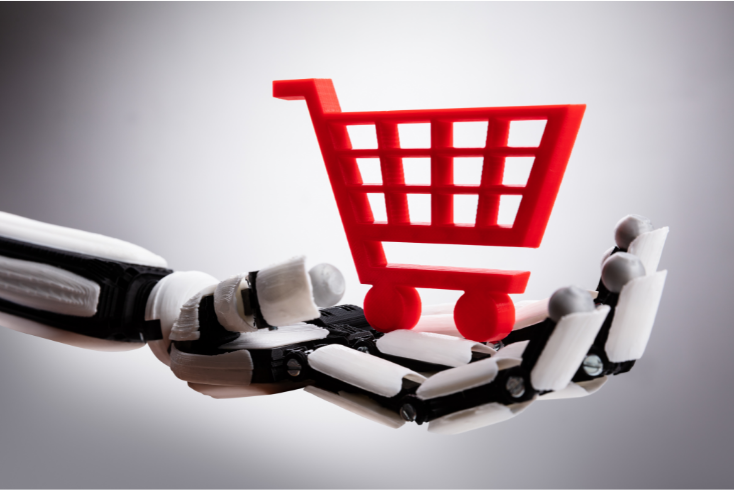Where AI is heading and how it can help retail media plans

OMD EMEA’s chief product development officer looks at AI’s evolving role in the purchasing funnel
The retail industry looks set to end this year, having poured more investment into Artificial Intelligence than the previous top AI-spending sector, banking, according to a recent report from International Data Corp.
Retail giants including Wayfair, Ikea, Walmart and Ocado are turning to the technology for a wider range of operations, from inventory management to delivery and more personalised online search and shopping.
Meanwhile, PwC forecasts that AI has the potential to add a 10% boost to the UK economy of £232bn before the end of the decade.
Serious investment in AI has moved it rapidly from proof of concepts with lots of potential to a major business focus, helped in part by the acceleration of e-commerce during the pandemic.
Retail will now be a major beneficiary of 10 years of technology innovation, which took place over the course of just 90 days in 2020 and AI will play a leading role.
But from a marketing perspective, how can AI’s rapid evolution help to capture consumer attention near the top of the purchasing funnel?
Capturing customer attention
OMD has focused on this challenge in recent years, measuring how different channels and creative formats deliver consumer attention and how that attention is best utilised to drive both mental availability and purchase.
Categorisation and AI-initiated personalised messaging can, and will be useful tools is this regard, so long as the value exchange is clear and obvious.
For example, the fashion retail brand that can categorise purchasing factors such as size, colour, design, brand, occasion, seasonality and lifestyle – and then overlay them with existing customer data such as purchase history, will have a distinct advantage in getting to know their customers better.
Capturing customer attention by offering a more personalised shopping experience creates an AI value exchange that is mutually beneficial to both the shopper and the in-store staff.
Grocery delivery service Hungryroot meanwhile, uses AI to learn consumer preferences to foods. On a weekly basis, the brand’s algorithm predicts groceries and recipes that customers may like and as a result, learns their dietary requirements and individual food trends.
As a shopper, trusting technology to understand your specific needs more accurately and at speed not only drives interaction, it is also worth sharing personal data for.
Looking to China
This growing trust in the utility of brands’ AI-based services ultimately holds the key to capturing attention and permissions that will drive more effective marketing.
Further down the funnel, attention is being utilised differently by AI. The opportunity here is to direct and manage attention rather than capture it.
For example, chatbots have evolved to tailor their introductions based on which website pages you’ve looked at or what video content you’ve watched. This increased sophistication means they can pre-empt frequently asked questions, product recommendations or customer service queries, providing faster resolution of consumer needs and converting intent to purchase.
[advert position=”left”]
Moreover, the partnership between global payments platform, Klarna and the online fashion marketplace ASOS, enables AI-driven marketing around the concept of deferring parts of payment for up to 60 days. Connecting fashion and a micro-loan nearer to the point of purchase gets around the pay-day problem that many ASOS customers face and enables a wider-range of products to become impulse purchases.
To understand where this opportunity is heading, we should look to China where an eco-system of micro-apps and mini-programmes have been interoperable within the major platforms for some time now. AI technologies are upgrading these services to drive sales at huge volumes.
During this year’s Singles’ Day (the retail event also known as Double Eleven and first started by Alibaba’s ecommerce platform, Tmall on 11 November, 2009) for instance, AI technologies were used to scan shopping baskets and wish-lists on the Taobao Marketplace as part of a ‘Zhongcao’ or ‘plant grass’ campaign – a Chinese expression for seeding ideas – in this case for other relevant purchasing ideas.
Betting on AI in 2022
We’re left in no doubt that the art of marketing strategy in the AI age will be based around connecting brand and product value to a greater range of contexts, need-states and value mechanisms.
The pace at which this can happen will be a function of continued technical evolution, combined with accelerated trust in individual brands to maximise value for their consumers in return for data.
The most appealing benefits of AI in 2021 have been the ones that make consumer lives easier and eradicate friction from the retail cycle, creating more convenient purchases and enhancing real-life experiences.
As we head towards 2022, we’re looking forward to how retail’s big investment bet on AI will result in utility at scale in the months ahead.
Jean-Paul Edwards is OMD EMEA’s chief product development officer




